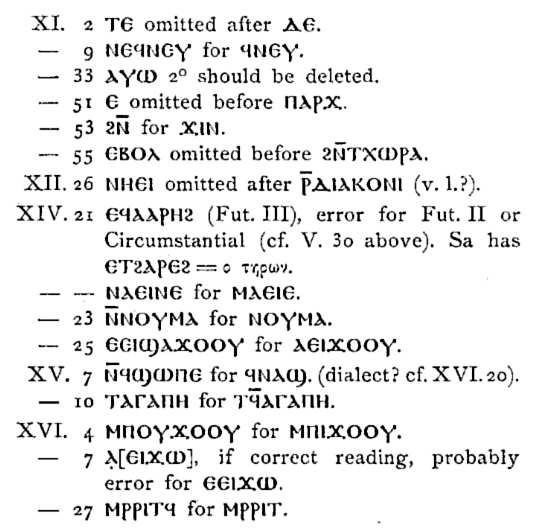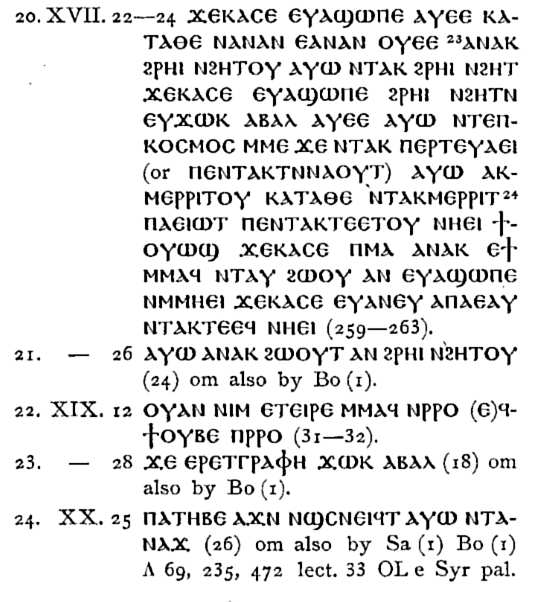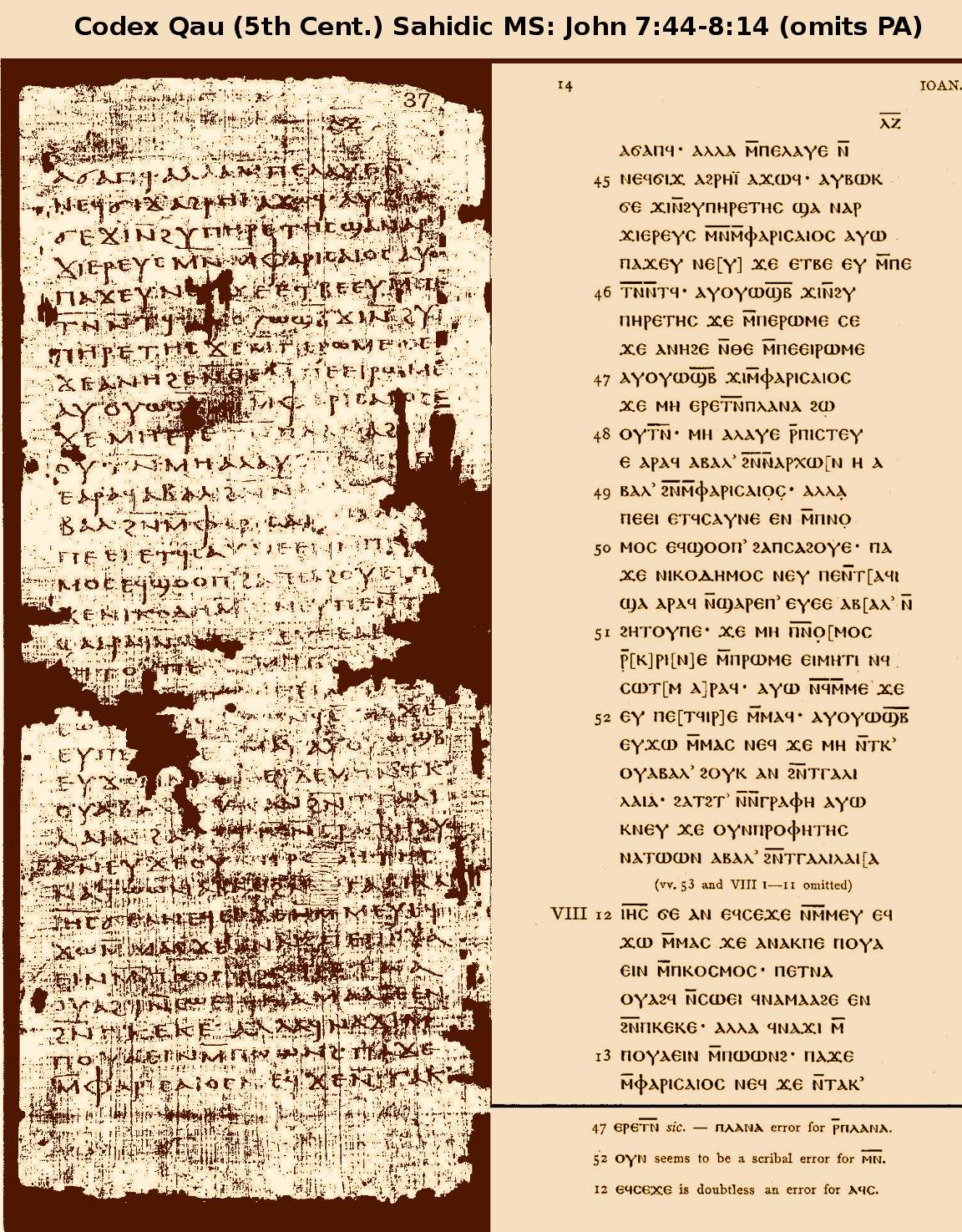Codex Qau
Excerpts from: Sir Herbert Thompson,
The Gospel of St. John Acc. to the Earliest Coptic Manuscript
(London, 1924)
Headings have been added for clarity and navigation purposes.
Codex Qau: Introduction
5th Century Coptic Book of John (p. XI fwd)
I. THE MANUSCRIPT
The papyrus is referred to in this Introduction as Q [Qau]. It is a book in Codex form of which 43 leaves, or fragments thereof, are extant out of a volume which originally contained 100 numbered pages, or 50 leaves, besides in all probability one or two unnumbered leaves at beginning and end.
The text begins at chapt. II.12 on a page numbered 7 and ends at ch. XX. 20 on p. 96. Therefore it is clear that six numbered pages, i.e. 3 leaves of text are missing at the beginning. We can tell the structure of the book by fibres of the papyrus. As all papyrus consists of two layers of fibres at right angles to each other, one face of a papyrus leaf presents fibres running in a horizontal direction and the other face in a vertical direction. These are denoted by H and V respectively.
In the present MS. every leaf is numbered and all the leaves bearing numbers up to 50 are VH, that is, they have vertical fibres the recto, or first side of the leaf and horizontal fibres on the verso; all leaves after 50 are HV; therefore pages 50 and 51 are both H, and formed part of one sheet originally, folded so as to make a double leaf. And so we learn that the book was made by taking 25 square sheets of papyrus about 10 inches each way and laying them one about the other, each with its horizontal fibres upwards, and then folding the whole mass in half so as to form a volume of a single gathering or quire. It must have been a clumsy sort of book; but the method seems to have prevailed for a time when the codex form of book was first introduced, though our evidence does not allow us to say that it preceded the method of multiple quires laid side by side.
Books vs. Scrolls
The transition from the ancient roll form of manuscript (still used for reading tlie law and the the prophets in Jewish synagogues) to the codex form is still somewhat obscure. It would almost seem to have been in some way hound up with the spread of Christianity. At any rate very few Christian literary fragments written on rolls have survived, and this is the more remarlcable when me consider what the Jewish tradition was.
The remains of the Pastor of Hermas in Greek at Berlin are parts of on an original roll: and the second set of "Sayings of Jesus" (P. Ox. No. 654) is written on the back of a papyrus roll. In Coptic there is in Paris a papyrus with four columns of extracts from the second book of Maccabees in the Achmimic dialect; what remains is only about 20 inches long and probably it never was a complete roll; and the ame remark applies to the papyrus fragment with extracts from a Coptic version of the Didache recently acquired by the British Museum.
The Roll-form continued to be used for legal and other documents to a much later date; but we are dealing only with Christian literary texts. The codex-form of book is generally supposed to have been suggested by the waxed tablets, which were used either in pairs (diptychs) or in larger numbers fastened together by cords passed through holes bored in the hinder wooden edges. Such a group of tablets seems to have been known as a codex, and the name was passed on to the papyrus or vellum leaves arranged in the same fashion.
But the more convenient holding together of a number of leaves, the system above described of folding sheets of papyrus into double leaves and placing them one inside the other was adopted in some parts of Egypt. Very few of these single-quire books are known.
...the size of the sheets was graduated, being largest in the outer ones and progressively smaller towards the middle of the book so as to give space for an equal amount of text on each leaf, and this seems to have been the case with Qau (Q), but the condition of the edges is for the most part too imperfect to allow of demonstration.
Qau: Physical Form of Text
Each leaf of Q measured originally about 10 inches (250 mm.) in height by about 5 inches (125 mm.) in width. The text was written in a single column covering about 8.5 inches (210 mm.) by 3.5 inches (85 mm.). There were from 33 to 37 lines on a page. Each page was numbered, as is also the case with the Acta Pauli and the Epistola Apostolorum.
There was no division of the text either by chapter-numbers or by enlargement of initial letters, or by extrusion of them into the margin.
The only mark is a ">" inserted at the ends of lines in 18 instances: their purpose is obscure, for they are not used, as in other MSS, merely to fill up short lines; the number of letters in a line varies from 11 to 25, and they are not used in specially short lines. They have no relation to the tituli [section titles] of the Gospel, to the B divisions nor the Eusebian Sections, nor to any lections that we know [existed] later.
Once what is apparently the same sign is placed at the beginning of a line corresponding to our ch. V:1.
The only punctuation is a high point; a colon seems to be used once on p. 9, l.1, perhaps a mistake. The apostrophe so often found both in Greek and Coptic early MSS is also found here above Κ Λ Μ Ξ Π Ρ Τ Φ, seemingly to guide the reader, when reading aloud, since there is no word-division, but the principles of its use have never been adequately explained. A circumflex accent is found occasionally over EI when it stands for the verb "come", as elsewhere (BM. Or.7594, Jonah; Rahlfs, Psalmenfr. p.16), and over O the qualitative of EIRE, doubtless to mark them as such.
The only contractions are IHC, XC ΠNA. The Superlineation for N at the end of the line is never employed.
Qau: Quality of Execution
The MS is written in one hand throughout and all the corrections are by the hand of the writer. The scribe was not exemplary; his list of errors is considerable. (see next col.) and the omissions due to scribal error are unduly numerous, though it is possible and even likely that some of thes are due to the scribe of his exemplar. He occasionally crosses out an error with a diagonal line, e.g. in V:45, X:37, XI:27, XIV:6, XVIII:6,36.
2. Palaeography and Date
The handwriting bears a strong resemblance to that of Codex Vaticanus (B), allowance being made for the fact that one is on papyrus and the other on vellum.
Consequently in Q there is not the same perfect regularity of letter-form that we find in B. The principal points of difference are:
Β is usually not quite closed at the top; in B always closed.
Ε shows a tendency to squareness at the top and for the foot to be small compared with the overhanging top. In B it is a fair half-circle.
Μ is square and very similar in both MSS. The round M occurs twice in Q, on p. the 7th line from the bottom in the word MA, and on p. the 14th line from the bottom in KOSMOS.
Ν is usually a little wider than square, and when broad the diagonal tends to sag.
ξ has a marked serif at the top; in B the top is quite flat.
Σ like E shows a tendency to flatness at the top.
Υ is rather large and less regular than in B.
ω is usually small and written well above the line; in B on the line.
Among the early Coptic MSS the hand of Q comes nearest to BM. Or. 7594 (Deut.-Jonah-Acts) and to the Berlin Clement; of the two closer to Clement, but it is not so heavy as either of them.
Sir Frederick Kenyon has given me an estimate of the date based on the study of photographs of the original; and he kindly allows me to quote from his letter. He writes:
"The manuscript to which the writing is most akin is the Codex Vaticanus. There is the same simplicity, the same rounded forms, the same slight irregularities in length of lines (though that is not peculiar to B), and a very similar general appearance. The only sign of a rather later date is a tendency to enlarge such letters as and , which becomes more marked in MSS of the 5th and later centuries. Taking therefore the 2nd quarter of the 4th century as the probable date of B, I should be inclined to assign the St. John [Q] to the 3rd quarter; though you know well that dogmatism is entirely out of place in these matters, and that a precise assignement of dates is not possible in dealing with MSS of this class and period. The hand is, however, so like the normal Greek hands (which is not the case with most Coptic MSS), and is so evidently the work of a trained scribe, that one may feel more confidence in assigning a date to it than is often possible with Coptic scripts."
3. The Text of the MS
Miscellaneous Scribal Errors
All mss have peculiar readings, and the earlier the MS, usually the more numerous they are. The first task, however, is to clear out of the way those peculiarities which are due to the scribe. It is not always quite easy to determine the border line and to distinguish between errors and variants. Here follows a list of the errors, or what appear to be such:
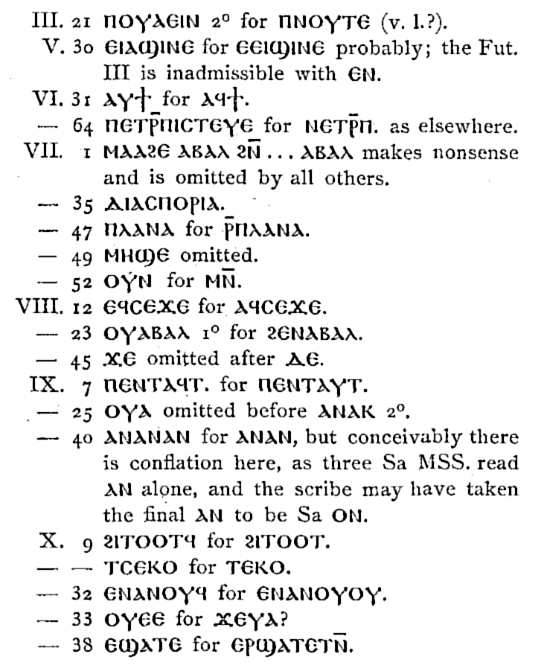
Omissions
Omissions may be divided according to whether they are due to the failings of the scribe or not. The former class may be divided into those which are due to what is called Homoeoteleuton, arising from the eye catching a similar group of letters in two adjacent spots and passing unconsciously from the one to the other, and those which are not due to this particular failing. The latter have already been recorded in the list of scribe's errors above. It remains to collect here: (A) omissions due to Homoeoteleuton,and (B) omissions NOT due to scribal error:
(A) Omissions due to Homoeoteleuton
These are numerous; the frequent repetitions of phrase in this gospel tend in most MSS to make this form of error more common than in any other book of the NT.
As there is no other MS in this dialect to control the missing words, it was necessary to take the corresponding portions of the Sahidic Version and adapt them to the dialectical forms of Qau; hence some uncertainty exists in one or two of the longer omissions as to the exact number of letters missing. The corresponding omitted Greek words will be found in the Greek collation. THe numbers in brackets immediately after each extract is the number of missing letters:
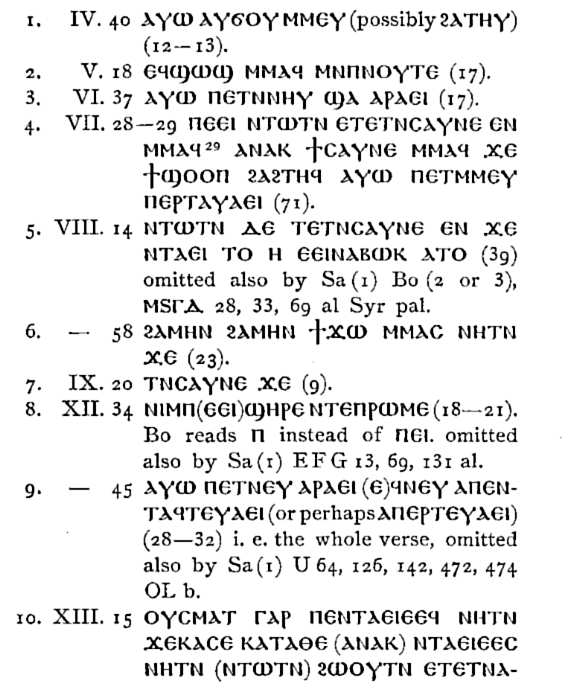
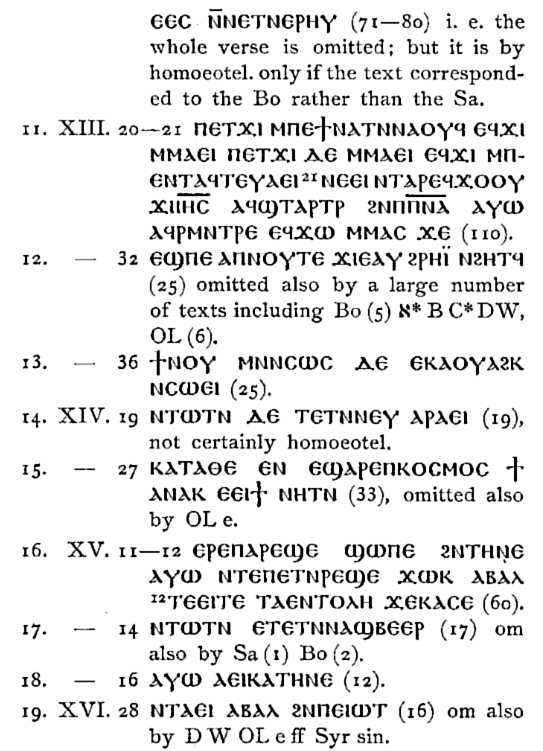
Calculations of Column Width for Exemplars (from homoioteleuton cases)
We may regard it as probable that omissions #5, 8, 9, 12, 19, 24, being so frequent in Greek as well as Sahidic texts, were present also in the exemplar of Qau, whose scribe may fairly be relieved of the responsibility for them.
Assuming that he is responsible for the remaining 18 instances, let us see if we can extract any information from them as to the nature of the exemplar from the numbers of letters omitted on the lines laid down by Prof. A. C. Clark 1. (The Primitive Text of the Gospels and Acts, 1914; cf. Cronin in Journ. Theol. Studies, XIII 563.)
The instances are those # 1-4, 6, 7, 10, 11, 13-18, 20-23; and the groups of letters omitted amount respectively to 12-13, 17, 17, 71, 23, 9, 71-80, 110, 25, 19, 33, 60, 17, 12, 259-263, 24, 31-32, 18.
At first sight a common denominator of a considerable portion appears to be 17. This applies to the following 17, 17, 71 (17x4 = 68), 71-80 (as last), 110 (17x6=112), 19, 33, (17x2=34), 17, 259-263 (17x15=255), 18.
That is to say, since the copyist's eye tends to be caught by a repeated word or words lower down in the same position, whether at the beginning, middle or end of a line, he is most frequently liable to leave out a single line or a number of lines of his exemplar, and so we arrive at the probable length of its line.
This would be satisfied by an exemplar of 16-18 letters to the line -- if we have regard only to these instances.
Exemplar of the Exemplar:
But his exemplar itself may have suffered in its own time from omissions which our copyist has merely passed on.
Let us take the reamining instances. They yield the following letter-groups, 12-13, 23, 9, 25, 60, 12, 24, 31-32. Omitting the group of 9 letters as probably a homoeoteleuton within a single line, we cannot fail to be struck by the remaining numbers; they group themselves round 12 as the center, with a refractory one of 31-32. The inference is that these instances are not due to the scribe of Qau, but to the scribe of his exemplar who was copying from a MS with lines of approximately 12 letters.
It is not suggested that these numbers prove the explanation offered -- the field is too small to eliminate the element of chance, but it is a possibility.
The line of 16-18 letters is practically that of Vaticanus, while in Sinaiticus it is rather shorter, 12-14 letters to the line.
Thus the exemplar in either case may have been a MS of two or more columns to the page, written for use in a large monastery or church, from which copies would be made for use in provincial churches on a more modest scale such as Qau; and the larger exemplar would very likely be bilingual.
(B) Omissions NOT due to Homoeoteleuton: i.e. Other Causes
(1) John 7:53-8:11 - The Pericope de Adultera is absent, as in all early African tradition.
(2) John 5:4 - is omitted in common with all other Coptic MSS (except some late Bohairic), and in common with א B C* D W 33 157 314 OL f1 q Vg(2) Syr-Cur. The additional words at the end of 5:3 are omitted in common with all Sah, most Boh א A* B C* L (not W) 18 157 314 OL q Syr-Cur.
...
(4) John 4:11 - Qau omits η γυνη with B, Syr-Sin.
(6) John 9:38-39 - Qau omits ο δε εφη πιστευω κυριε και προσεκυνησεν αυτω και ειπεν ο Ιησους with א* W OL b. OL omits at ille ait credo dne and dixit ei Ihs (inserted by a later hand). I can find no reason for the omission which would seem to owe its strange distribution to the reactions of bilinguals. The union of Qau and b here is one of the strongest pieces of evidence of an early Gr.-Lat.-Coptic trilingual. But it throws no light on the question of how such an omission can have originated. (Cf. p. XIV supra.)
...
(10) John 17:8 - Qau omits και εγνωσαν with א* A D W OL a e q Vg(R) Goth.
(11) John 17:11 - Qau omits ω δεδωκας μοι ινα ωσιν εν καθως ημεις with OL a e ff r
(12) John 18:22 - Qau omits παρεστηκως. There is much variation here, but no support for the omission.
(13) John 19:5 - Qau omits και λεγει αυτοις ιδου ο ανθρωπος with OL a e ff r, again two versions and though a Greek link has not been found, it points in the same tri-lingual direction [D and d hiant.]
(14) John 19:5 - Qau omits γυναι in the words from the cross to his mother. The omission occurs also in 11 out of 20 Boh MSS, though the word is present in all Sahidic. The only other supporting text is OL e; neither Cyprian nor any other African authority seems to quote this text.
4. The Dialect of Qau
THe dialect in which the text is written differs from Sahidic somewhat, though the version is the Sahidic version. IT is already known to us by one important text, the Acta Pauli, and some lesser documents.
Prof. C. Schmidt has described (p. 14) the dialect of the Acta as being consonantally Sahidic with a vocalization closely resembling the Achmimic; and this is just what we find in Qau. The Achmimic ξ is wholly absent; so to is the past relative ETAS=, but there are numerous instances of a primitive past relative EP= (see below)....
(cf. Acta Pauli, herausgegeben von C. Schmidt, Leipzig, 1904)
4. The Version of Qau
The version contained in Qau is unquestionably the same that we find in later Sahidic MSS. Except for the dialectal form given to most of the words, and the few instances in which one word is actually replaced by anotther (see list on p. XIX), the rendering is word for word the same, subject also to fairly numerous differences of reading, to which we shall return.
But first it is desirable to refer to another point. The dialect of Qau being so closely allied to the Achmimic, the first question that presented itself was whether this was a copy of the Sahidic version or of the Achmimic version. It has usually been said that the Sahidic and the Achmimic were to distinct versions; (e.g. Leipoldt, Church Quarterly Rev. 1921, vol.92, p.50)
But Prof. Burkitt in his article in the Encycl. Biblica so long ago as 1903 said that the Sahidic and the Achmimic versions were not independent, and after a renewed comparison of all the extant remains of the two versions, I am convinced that this is the correct view, or rather more positively it may be affirmed that they are one and the same version.
This being so, presumably the Achmimic remains represent the version in its earliest form, that dialect being certainly nearer to the older language in its vocalisation, so far as our limited knowledge of it in the earlier time goes, and in the use of a considerable number of words and grammatical forms which we may call archaic insasmuch as they did not survive into Sahidic or Bohairic.
Then we may take it that the original rendering in Achmimic (as we style it) underwent a gradual transformation of dialect and a considerable amount of revision before it reached the stage in which the ordinary Sahidic version is known to us.
It is very unfortunate that most of our Achmimic fragments are of O.T. books. Of the NT we have only the Epistle of James and a few fragments of the Epistle of Jude and of 3 chapters of St.John (very fragmentary) for comparison.
I am absolved by the fact of Qau being an example of the Sahidic version from a detailed investigation into its textual character; the textual critic can obtain the details from the full collation given below with the Greek text of Westcott-Hort (p. XXXI seq.).
But though its general quality is thus fixed and it is therefore affiliated to the so-called Hesychian Recension, this does not alter the fact that it is the earliest considerable portion of the NT in this recension in Coptic that we possess, except the Acts of the Apostles in the B.M. Or. 7594; and its text presents a number of important variations from that recension as known to us in the Sahidic version.
Photo and Text of Keypage
Notes: Damage to the right-hand side of this page make it impossible to establish whether any diacritical mark or note existed in either the margin or text at the point of interest (Jn 7:53-8:11). A higher-resolution photo might be of assistance in the future.
